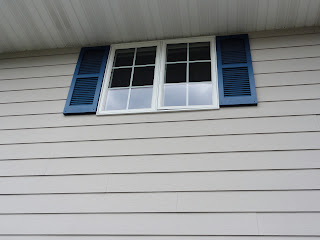Here is my tutorial for the headboard we just made. I'll apologize in advance that it will not be a detailed tutorial with instructions on how to do every minor step. I think most people can figure out how to do this stuff!
**As a disclaimer, I am not claiming to be a carpenter or professional, this is just the process the worked for us.
The materials you will need to make a headboard are:
- A sheet of plywood cut to size (our headboard is 2.5 feet tall and about 6 feet wide because we have a California King bed).
- A 1 x 4 piece of wood cut into the height from the floor to the top of the headboard (ours was about 4.5 feet tall).
- Batting
- Foam (or in our case, carpet padding)
- Fabric
- Staples and staple gun
- Screws, nuts and bolts
- Nailhead (optional)
We laid our piece of wood on the garage floor and cut the carpet padding (we used carpet padding because it was about 1/4 the cost of foam that we found at Jo-Ann and nobody was going to see it.) to the size we wanted. I wanted there to be a 2" space around the headboard so we could pound in the nailhead. Plus, it gives it some dimension.
What the foam looks like.
Measuring.
We did 4 layers of 1/2" carpet padding. We stuck them together using a spray adhesive.
After we had the foam on, we used the staple gun to staple on a layer of batting. The batting just adds another layer of "cushiness." I don't know if it's 100% necessary, but I guess it protects the fabric from any splinters in the wood, too.
Stapling the batting to the back of the board.
You want to get the batting as tight as possible against the wood, so this is really a two person job. We stapled down one side, then pulled the other side tightly and stapled that side.
Next, of course, is the fabric. This was probably the trickiest part of the project because obviously we wanted it to look really nice. We had to figure out how to get the fabric to look nice around the corners and make sure it was super tight as we stapled. Don't want a saggy headboard!

What we did was make sure the pattern was even so we didn't have crooked zig zags, then stapled along the bottom side of the headboard, then the top. Since we had that raised area, we stapled around that section, then worked out the outside left and right edges. The whole time we made sure that the fabric was tight against the board and that the pattern was straight.
Once we had the fabric stapled, it was time to add the nailhead trim to that 2" border around the edges. We went with a roll of nailhead instead of pounding in individual nails. That sounded like absolute torture, so we went the easy route. With the roll, we only had to hammer every 5th nail.
Lazy crafter's dream.
Close-up of nailhead goodness.
The nailhead didn't go as smoothly as we expected. We ben about 25 nails trying to hammer them in and it was tough to go around the corner naturally. There are a few spots where the nail went in a little out of line, but I never said I was a perfectionist. And this method seriously beats trying to line up individual nails.
Once the nailhead was on, we were pretty much done! All that was left to do was nail the 1 x 4 posts onto the back and mount it on the bed frame. As I previously mentioned, our 1 x 4s were 4.5 feet tall because the headboard was 2.5 feet tall and then it was another 2 feet to the floor. We wanted the headboard to start right at the top of the mattress. This portion of the project was all my husband's doing, so I don't really know how he figured the rest out.
Boards screwed to the back of the headboard
Screwed to the metal bed frame.
The reason we chose to screw it into the bed frame instead of getting brackets for the wall was because 1. We didn't want to put all that hardware on the wall and 2. We want to be able to take the headboard if we ever leave this house and typically things that are screwed into the wall have to stay.
Once we had that sucker screwed in, we moved the bed back into place and admired our work!
This is the biggest project I've ever done in terms of size, but it actually didn't take that much time. I'd guess we spent about 10 hours total on the whole thing including shopping, gluing, stapling and assembling. Not bad!
Another thing I love is that this was a pretty cheap project for the size of it. Below is a cost breakdown.
- 4' X 8' sheet of plywood (cut down to size): $16.97 @ Home Depot
- 10' 1X4: $2.28 @ Menards
- Carpet padding (used as foam): $15 @ Menards
- Spray Adhesive for foam (used about half): $9.97 @ Home Depot
- Batting: $20.97, but used 40% off coupon: $12.58 @ JoAnn
- Staples for batting and fabric: $2.95 @ Menards
- Nuts and bolts for screwing headboard to bed frame: $4.39 @ Menards
- 3 yards of fabric: $54 with 5% discount and shipping from Tonic Living
- Nailhead trim: $27 with shopping from Fabric Farms Interiors (through Amazon)
Total: $145.14
I think this is extremely reasonable, considering how much you have to pay a store for a headboard!
Good luck if you try it on your own!





































